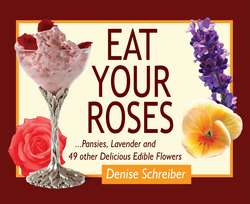Читать книгу Eat Your Roses - Denise Schreiber - Страница 7
На сайте Литреса книга снята с продажи.
ОглавлениеINTRODUCTION
the thing perhaps is to eat flowers and not to be afraid
e.e. cummings
Eating flowers is one of the true pleasures in life, providing sustenance to our senses and renewing our joy in food.
I discovered the world of edible flowers back in 1999, when two friends and I decided to go to England and Wales to visit the famous gardens there. Joanne was a horticulture professor, Michele a landscape architect from Longwood Gardens, and I was greenhouse manager for Western Pennsylvania’s Allegheny County Parks. We pored over garden books and planned our grand tour, each picking out her “can’t miss” garden.
Arriving in London at the beginning of June, we picked up our rental car and taught ourselves how to drive on “the wrong side of the road” in the airport parking lot. We stayed in B&B’s and toured gardens large and small, some on the itinerary and some that weren’t. Our last stop was far off the beaten path, at Mottisfont Abbey in Hampshire. We found it by driving down a road that can only be described as a goat path that opened up into a breathtaking vista of roses. The original building at Mottisfont was a priory, founded by an advisor to King Richard the Lionhearted, King John and Henry III. Today, Mottisfont Abbey is home to the famous collection of historic shrub roses created by Graham Stuart Thomas (you might say they smelled good enough to eat, but that’s getting ahead of the story).
I fall in love
Like so many other public gardens, the Abbey has places for that wonderful English tradition known as afternoon tea, which sustains you until dinnertime. Joanne and Michele opted for tea and scones; I, on the other hand, spotted a little cup of rose petal ice cream. I have to tell you that I consider ice cream one of the main building blocks of the food groups.
I put a spoonful into my mouth and discovered heaven on earth. The fragrance of the roses enveloped my tongue with perfume like nothing else I had ever eaten. I was in love. Unfortunately, there was no one around to ask for the recipe. When we came home I searched the Internet and found not only rose petal ice cream but a whole world of edible flowers and recipes. I started making some of the dishes, creating new recipes, experimenting with the endless varieties of flavors. And that is how this book came to be.
Who eats flowers?
Often, when I first mention to my guests that I cook with edible flowers, they roll their eyes at me, thinking I’m going to have them grazing on flowers. Actually, just about everyone has eaten edible flowers at some point in their lifetime. Zucchini blossoms in an Italian frittata, dandelion wine, rose petal jam and rose hip jam, broccoli, Brussels sprouts – all are examples of edible flowers and flower buds. There are the flowers of common herbs, thyme and rosemary among them, and some derivatives too, such as the seeds and seed pods of plants like sunflower seeds and the quintessential vanilla seed pod from Vanilla planifolia, a member of the orchid family. I was amazed to discover the extent of the edible flowers available to me.
More than just a pretty face
Not only are they used as food, some companies use them in vitamins and supplements – lutein, for example, which is in vitamin formulations for eyesight, and is derived from marigolds (Tagetes species). For a period of time there was a product on the market that was designed to “increase pleasure” for women with natural ingredients. The ingredient was Salvia officinalis, also known as common garden sage, a seasoning used for Thanksgiving turkey stuffing. So instead of taking a nap after dinner, you might be having other thoughts.
But this book isn’t about remedies or being serious about eating only flowers. It’s all about having fun with your food by taking everyday recipes and changing them into something unique – and of course to impress your friends and family too!
I wish you many happy edible adventures with the flowers in your life. Bon appétit!
